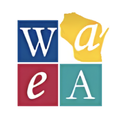- Students in the midwest already have the lowest access to visual arts education in the U.S.
- WIStatutes-L-DPI BluePrint ...In grades K-8, provide regular instruction in language arts, social studies, mathematics, science, health, physical education, ART and music. In grades 9-12, provide access to an educational program that enables pupils each year to study ART.
- Standard K. Develop a written, sequential curriculum plan...Definition: “Sequential curriculum plan” means an organized set of learning experiences that build upon previously acquired knowledge and skills...Each sequential curriculum plan shall include a program evaluation method which provides a systematic, continuous and objective process of determining whether pupils attain the specified objectives.
- WIStatutes-J-DPI BluePrint ...Therefore, it is essential that art education be an integral part of elementary and secondary education for ALL students. As part of the general learning process, art balances the curriculum to help develop the whole intellect. Art education fosters perceptual awareness, visual creativity, aesthetic valuing, understanding of the past and present cultures, life coping skills, aesthetic literacy, communication skills, and experience in understanding one’s self.
- PI 8.01(2)(L) In grades 5-8, regular instruction will be provided for ...Art...In this subdivision, regular instruction means that instruction will be provided each week for the entire school term in sufficient frequency and length to achieve the objectives...OR In grades 5 and 6,each week for the entire school term or the equivalent in instructional time and course content...In grades 7 and 8, in sufficient frequency and length to achieve the objectives and allocation of instructional time identified in the curriculum plans developed and adopted under par. (k)
- An Open Letter to Superintendents, Principals, and School Board Members Visual Arts/Design Instruction for All Learners Is More Essential Than Ever
- In 2015, the president signed into law the legislation (S.1177 Every Child Achieves Act of 2015) to the reauthorization the Elementary and Secondary Education Act (ESEA). Every Student Succeeds Act includes the arts alongside math and language arts in its definition of a “well-rounded education.” (Check page 807.) That ensures that arts education programs and teachers are eligible to receive federal funds through provisions such as Title I, which supports disadvantaged students, and Title II, which supports teachers.
















